#fish feed supplements
Explore tagged Tumblr posts
Text
Have I ever mentioned I caught my horse eating meat? She ate a dead pheasant, possibly more. Its very common, they have like a mile of intestines so meat is easily digestible by them. They shouldn't be let around baby chickens because they'll eat them whole sometimes. Contemporary sources claim the Hunnic warriors fed their horses venison after hard rides :)
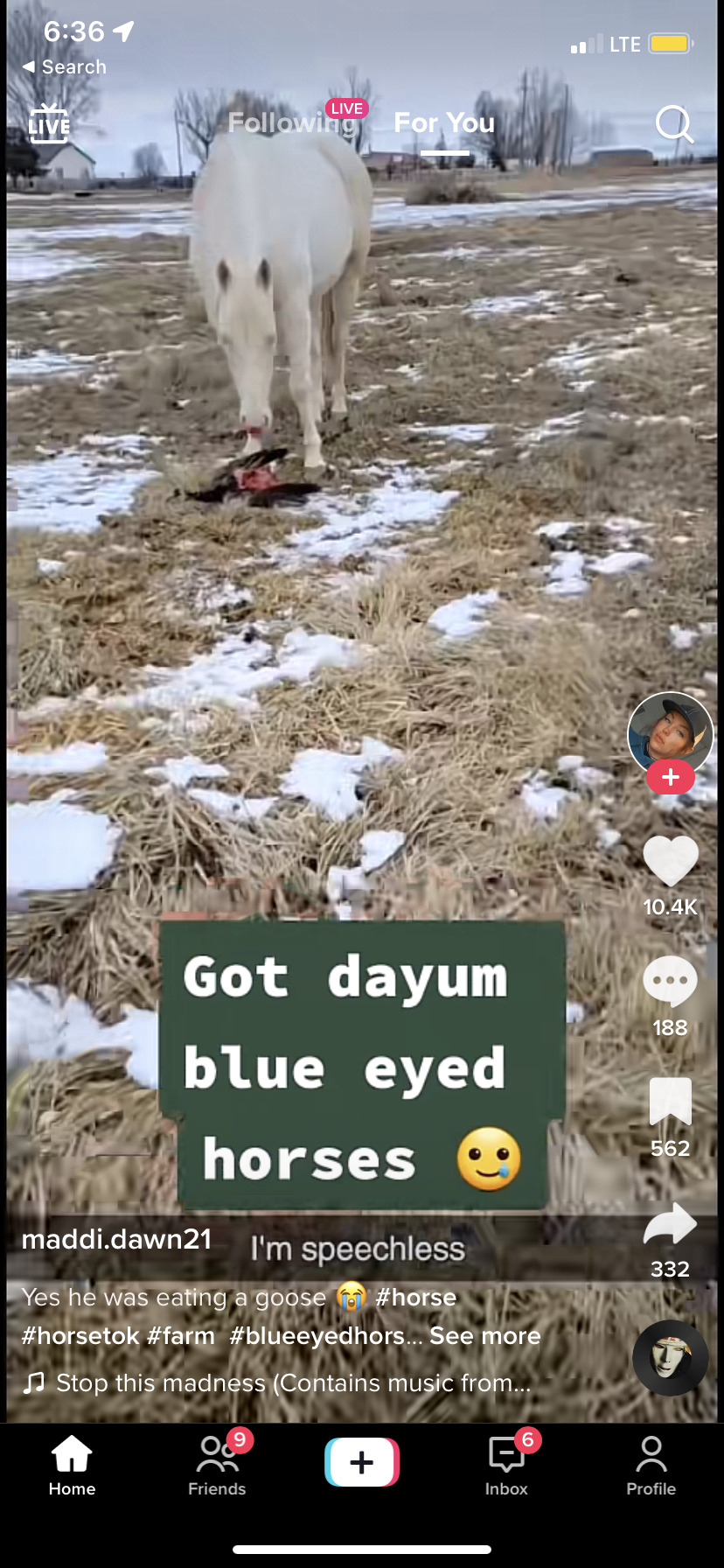


I WOULD START LOOKING FOR HOUSES IN A DIFFERENT STATE
#its the ciiiiircle of life#herbivorous is really more of a suggestion#although the owner should look into food supplements usually they do it because they aren't getting something they need#My horse gets fish oil#if I didn't have supplements I'd probably just feed her some fish#she eats everything anyway
25K notes
·
View notes
Text
Aquatic Animal Nutrition
Aquatic animal nutrition is essential for promoting the growth, health, and productivity of aquatic species such as fish, shrimp, and mollusks. Proper nutrition supports immune functions, reproductive health, and resistance to diseases. Essential nutrients, including proteins, lipids, carbohydrates, vitamins, and minerals, are key to formulating diets tailored to specific aquatic species. Advanced feed formulations and sustainable aquafeed innovations are crucial to optimize the feed conversion ratio (FCR) and minimize environmental impact. Effective aquatic nutrition strategies are vital for aquaculture sustainability and increasing production efficiency.
0 notes
Text
Enhancing Aquaculture Growth: The Impact of Prebiotics on Weight Gain
Aquaculture, the practice of cultivating aquatic organisms, is essential for meeting the growing global demand for seafood. As the industry seeks to improve the health and growth rates of farmed species, prebiotics have emerged as a valuable tool. Products like Vinmos Aqua Prebiotic are designed to enhance weight gain and overall health in aquaculture species by promoting a healthy gut environment.
Prebiotics are non-digestible ingredients that beneficially affect the host by stimulating the growth and activity of advantageous bacteria in the gut. Unlike probiotics, which introduce new beneficial bacteria, prebiotics feed the existing beneficial microorganisms. This selective stimulation helps maintain a balanced gut microbiota, crucial for efficient digestion, nutrient absorption, and overall health.
Vinmos Aqua Prebiotic is formulated to improve feed efficiency and promote weight gain in aquaculture species. By enhancing the gut microbiota, it supports better digestion and nutrient utilization. The beneficial bacteria activated by prebiotics produce short-chain fatty acids (SCFAs), which serve as an energy source and help regulate appetite and energy metabolism. This leads to improved growth rates and significant weight gain in farmed aquatic species.
Prebiotics also play a critical role in enhancing the immune system. A healthy gut microbiota can produce antimicrobial peptides and other immune-boosting compounds, helping aquatic species resist infections and diseases more effectively. This reduction in disease incidence decreases the need for antibiotics and other chemical treatments, promoting a more sustainable and environmentally friendly approach to aquaculture.
The benefits of prebiotics extend to the sustainability of the aquaculture industry. By improving feed conversion ratios, prebiotics help reduce the amount of feed needed to produce the same amount of biomass. This efficiency lessens the pressure on wild fish stocks and other feed resources, contributing to a more sustainable feed supply chain. Additionally, healthier and more resilient fish populations are better equipped to handle environmental stressors, resulting in more stable and productive aquaculture systems.
prebiotics like Vinmos Aqua Prebiotic offer a promising solution for enhancing growth performance and overall health in aquaculture species. By supporting a healthy gut microbiota, prebiotics improve feed efficiency, nutrient absorption, and immune function, leading to better weight gain and more sustainable aquaculture practices. As the aquaculture industry continues to grow, incorporating prebiotics can help address key challenges and ensure the long-term sustainability of this crucial sector in the global food system.
For more information visit us:
0 notes
Text
How to Supplement Dog Food
There are many reasons your dog may need supplements including vitamin or mineral deficiency, prevention of inflammation, toxin exposure, allergies or intolerances to certain foods, and even for overall wellness. Your dog may also need supplements incorporated into their regimen based on their life stage. For example, if you have a senior dog, there’s a chance their body is no longer absorbing…

View On WordPress
#dog food supplements#feeding your dog a raw diet#fish oil for dogs#how to supplement dog food#supplements for dog food#supplements for dogs
0 notes
Text

@couldnt-think-of-a-funny-name
While that is sweet and all, field dressing is a LITTLE more macabre.
(Warning: I'll TRY not to get too graphic, but it's still hunting practices, animal death, and processing meat, so continue at your own risk)
Field dressing means to remove all an animal's internal organs and is usually required in most states when you kill big or small game. It's done ASAP so that the meat cools quickly (preventing bacteria growth). There's also the fact that when something dies, their gut biome DOESN'T. So the longer the guts stay in, the more likely it is that the meat will be ruined. The law about field dressing and harvesting the meat has multiple reasons behind it.
One, it makes the body easier to move because it's a LOT lighter.
Two, it keeps people from being wasteful by leaving meat that humans can consume behind. People who kill for trophies (or just cuz) still have to field dress the animal and can then give the meat away or (in some states) donate it.
Three, it cuts back on people decimating populations for fun or trophies. Field dressing an animal, getting it back, and either donating it, giving it away, or going through the muti step process to have the meat for your own use is a LOT of work. It makes you stop and think if the animal is worth the trouble.
Four, if you're getting meat anyway and you're following regulations on limits based on sex (depending on the local population of a species that is often hunted for a feature one sex has that is considered a trophy), you're less likely to exclusively hunt larger, tougher animals of one sex in prime breeding condition, so the population is more stable and balanced (also helps with overpopulation of species that might eat all the food and leave nothing for the others).
Five, it makes people hunt responsibly. If you drop an animal (dies where it stands), it's a quick death and its literally right there. If you're bad at it or half ass it, the animal could run off. That could mean literal HOURS searching and trailing and even THEN, you might never find it. There's also the possibility of injuring the animal and them surviving with the consequences of that injury or dying much later because of it. A lot of people if they were allowed to would just shrug and walk away because they didn't want to bother spending time tracking it.
There are special rules for things like invasive species (one species back from where I was from had no limit and no requirement of field dressing or saving meat because they were taking all the resources of native species and putting them at risk), but all the rules are there for a reason and Game and Fish/Department of Wildlife don't fuck around. If they did, the local population could get so messed up that it would take DECADES to recover (if it ever did).
That musher was unlucky because they VERY PUBLICLY killed a big game animal. If the agency just let them keep going WITHOUT following the regulations, it would have sent a bad message to everybody watching and reading about it. Same thing goes for fining the musher after. As it stands, the agency message is clear: no we really don't give a fuck how good your excuse is, you will still get in a load of trouble if you break regulations.

I love this place
#i used to help hunt and process deer and squirrel#we were very poor and that and fishing helped us supplement what food we could afford to buy/grow#it helped us not only feed ourselves but also have enough food to have friends over sometimes without us taking a big hit from it#I remember how mad my dad and papaw used to get over bad hunters and people shooting things just for fun and leaving the carcass behind#I don't hunt anymore but the meaningless death of any animal is still something I don't take lightly#hunting#news#meat#guns#musher#iditarod#carcass#animals#animal death
21K notes
·
View notes
Text
Fish Feed Supplement | Liver/Hepatopancreas Stimulant
Shop from a huge collection of best Fish Feed supplement and Liver/Hepatopancreas stimulant of your Pond. Visit Assent and avail the best rate.

0 notes
Photo


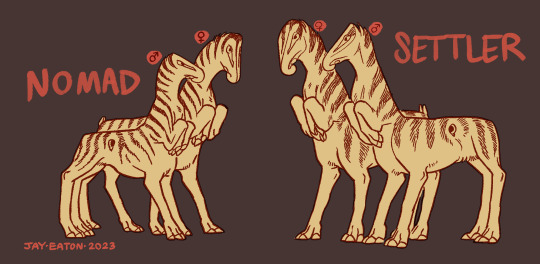

Centaur Aliens Lifespan: 80 years Adult weight: 500-1000 kg Adult height: 2.5-4 meters Visual range: near infrared to blue Diet: Obligate hypercarnivores Centaurs' evolutionary ancestors were savanna pack predators who used ambush to hunt prey, nomadically following prey animal herds as they traveled round the global continent every year. Modern centaurs emerged when they started to use tools to help with hunting and land management, eventually resulting in some groups settling down and becoming reliant on fishing, animal agriculture, and food preservation to survive. Centaurs remain obligate hypercarnivores, meaning approximately 70% of a healthy diet is meat and animal products, but they opportunistically supplement their diet with grain, starchy tubers, and small amounts of roughage and vegetation. Similar to humans, centaurs have a bisex reproductive system with an inseminator sex and gestator sex who gave birth to live young, but functionally are more akin to Earth's marsupials. Centaur’s distant ancestors had larvae that lived in the soil like grubs before pupating into adults, and their viviparous silk eating clade first emerged after parental care of the larval stage evolved. While other members of their clade have development and pupation both happen in-utero, centaur litters leave the womb early and feed on their parent’s nutritive silk until they are large enough to pupate, spinning a cocoon on their parent’s back. They emerge as an imago, resembling a miniature adult with the physical capacity of an six-week old kitten. Centaurs are pseudo-eusocial, with a social structure hierarchy somewhat similar to meerkats. At its most basic level a clan consists of one matriarch, a female who is responsible for bearing the clan's young; the entourage, who are the matriarch's partners and usually mostly male; and the clan's "workers," who are not involved in reproduction. These non-reproductive clan members are generally either the matriarch's children, childless relatives, or individuals married in for their skills or political purposes. Read more about centaur biology on my janky eternally work-in-progress website here, or look at the old centaur reference post here. PATREON | STORE | Runaway to the Stars
#rtts centaurs#speculative biology#jayart#runaway to the stars#yaaaay finally an update to the janky ass old reference post
6K notes
·
View notes
Text
˚₊‧꒰ა ed tips ໒꒱ ‧₊˚
( in depth…)
(skip don’t report pleasee)
- diet soda (not a very healthy choice)but a tasty one
- gum! i love gum especially when ik i just wanna eat something because im bored 🤔
-safe foods!!find ur fave low cal food heres some of mine⬇️
tuna packs (70-120 cals) i love adding stuff to these! also a good source for protein
pickles for obvious reasons (0-5 cals)
popcorn!!! there’s so many low cal options its kind of a “volume” snack to me (80-160 cals)
club crackers mini aghhh i love theses another “volume”snack in my opinion cmon 34 pisces for (140 cals)
gold fish LOVE (120cal)
shrimp is a nice choice each shrimp is like under 10cals (70-100 cals)
LIGHT string cheese i honestly like it way better that the original (50cals)
monsters or any other low cal energy drink(also not a very good choice) (5-20 cals)
cucumbers i rec adding something on top like lemon pepper/juice, Chamoy, tajin or any other low cal topping (10-45 cals)
pita crackers!! another must for me✋i’ve found that i’ve cut out corn chips since i’ve tried pita crackers they’re great for dips or just a side snack(130cals)
(i have lots of more food recommendations if y’all want more!!)
- check your weight daily or a few times a week i find this helps motivate me especially when i eat more than i should and start gaining.
-make sure you’re taking some kind of vitamin/supplement every day!!(you don’t wanna develop any more of a deficiency)
-do something that burns calories like walking, an at home workout, just dance,etc.
-TEA try making a cup of tea instead of feeding into ur hunger pangs
-read!!(one of my personal favs;) distract yourself with a book, especially if you’re a ao3/wp girly🤭(iykyk)
-music🎧 i love listening to music and just scrolling through pinterest or organizing my phone
-SCROLL ON TUBLR(like the last tip ^)
-go outside. you can find a place to sit get some fresh air i like to go out on my trampoline and watch videos/music:)
-hobbies!!!find yourself a hobby i like to distract myself by making kandi bracelets i also like to paint or any other arts and crafts.
-FASTING!! fasting is a major part of my daily life now i fast every day for at least 15-20hr a day
-watch yt,a show, or a movie. i like to distract myself with long forms of media. (i recommend watching some lolcow commentary on yt 💀)
-clean/organize! you can clean or organize things in your room,bathroom,kitchen,etc..
-self care🌟 i recommend taking care the outside of your body<3 (cause girl I know the inside ain’t doing too well😣) if you need motivation or ideas go on TikTok or YouTube watch some sc video:)
-make sure you have a meta day(basically a day for your metabolism where you eat at a normal calorie intake this is to make sure ur metabolism doesn’t crash)
-after a long binge when you decide to restrict again, make sure you do it slowly (restricting your calorie intake too fast can also cause your metabolism to crash)
#3ating d1sorder#tw ana rant#low cal meal#tw ana bløg#tw ed ana#low cal restriction#mealspo#meanspø#tw 3d vent#anor3c1a#tw ed not ed sheeren#tw ana mia#anadiet#i just want to be thin#thinspø#tw skipping meals#3d blog#b0n3sp0#tw edtwt#3d but not sheeren#3d f4st#3d not sheeran#34t1ng d1s0rd3r#3d relapse#3d diary#tw 3d diet#@n@ meal#meal$p0#mealspø#mealsp0
199 notes
·
View notes
Text
Some notes under the snacking issue of Sebastian post caused my brain to weeoweeo it way too much than I expected, so well here are the continuing of topic xd
Sorry it's an essay because I can't write succinctly
1. How did the evil corporation(insert it’s name please) feed?
As far as I’m concerned, the shady corpo experimented on him to check/make people to able to breathe under water. Keeping him alive was quite crucial to success so I think they would provided him with proper amount of of food or at least the full nutrient content preparation. However, it changed when his body started to rapidly mutate, grow and evolve into what he’s now. The vast increase in his need of food and the fact that the gills didn’t develop very well, due to the scientists not very smart move - mixing his DNA with atmospheric oxygen snake and whale, caused the team to shrink his portion and gave him bare minimum in form of drip-feed… Auch
2. How didn’t he die from literally any nutrient deficiency sickness?
As I said it before I do not know the lore very much only basis. So forgive if I mess up some facts about the events. Going back to topic, after the event of beating the life out of his guards/special troops everyone left the lab immediately. Leaving everything behind including the rations, which were sent there for the staff to eat, all kind of medicine - pills, drops, syrups, injections etc. and whatever crops left( no idea if in the game is any „farm” but the transport would be extremely expensive so I think they would love to slash costs especially when there are vertical farms which are efficient, cheap and easy to maintain and during evacuation they could simply destroy it if nothing like this exists there). He simply gain most of crucial elements via all those supplements. Especially via drips which are the least painful without activating all digestive track. I like to think the reason why his extra arm is in the bandages is the fact that he often injects himself with various needles and his veins are in horrible state. At some point point all these supplements will end and it won’t end well for him, but not yet. That’s solves a bit the issue of lack of scurvy, nyctalopia and any other issues alike. Here’s the misery fish and his banana bag of lovely Zn and vit C
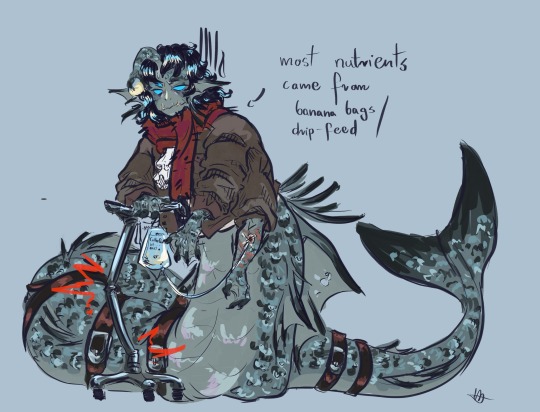
3. Another snacking issue
He is in constant state of hunger. No escape from it. The small human stomach ruthlessly dictates the size of his next snack and for how long he cannot eat, because it’s full, but it’s better to have at least one full than none. That could cause another big issue which is connected with the unconditional reflex - food in mouth equals activiting the synthesis of digestive enzymes and HCl in both tracks at the same time. Both are connected to one nervous system and the information goes to both, no matter if only one should start working. Not good situation, one belly is digesting itself,easy way to get ulcers or esophagitis, which not only are extremely painful but also deadly especially in his case with no health care or even chance to get any. He had to figure it out quite quickly how to make his eating as harmless as it’s possible. The easiest way I think would be simply some herby stomach drop, the one which highers the ph and stops HCl from being created. But I fear it works on human part- So he had to create strict timetable - when he eats, when he takes drops, when he can eat again. To keep the snake stomach in check and never letting it be fully empty and miraculously avoid the sinister autodigestive ideas of snake element. So his best friend is a tiny bottle of disgusting drops from a nurse office
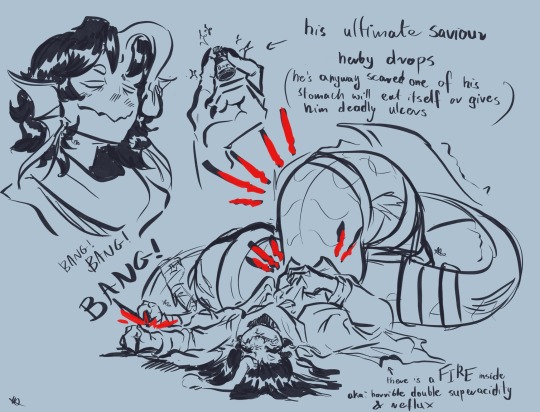
4. How not to starve to death with body like that?
Dense soup. Maximum proteins in the smallest velocity and in easy to consume and digest way. It passes both stomachs faster because tough long chains are already broken into smaller ones so it can be faster absorbed and used. It’s also very easy to make and can contain many ingredients giving the biggest diversity in one sip. Still starves because it’s not enough, but there is no better way :”)
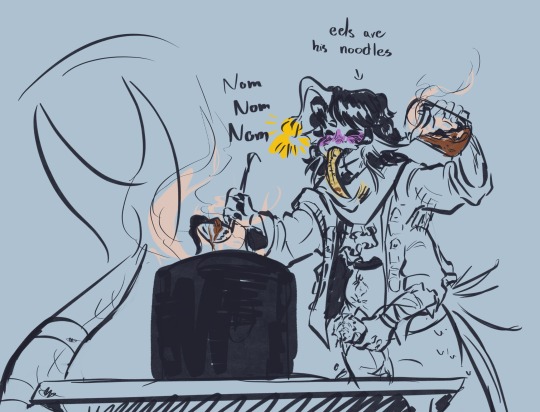
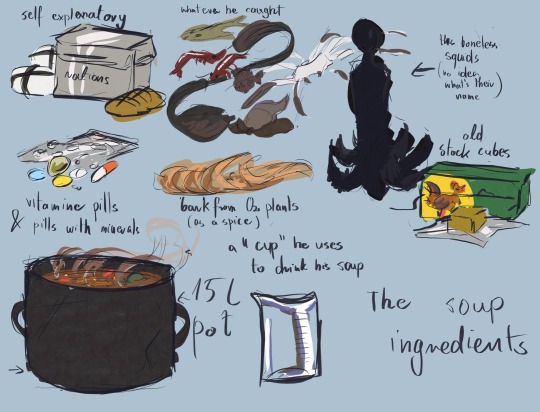
And no he wouldn't threaten anyone that he would add them to his soup. He was a human and he exactly knows there are too many weird fellas out there. No way he'll risk getting new traumatic event, he won't take it anymore-
The last thing is this two sentences:

Honestly I wasn't prepared to read something like this with straight face at 6AM. It wasn't in my weekly bingo card, but jup it made my day, thanks
#sebastian solace#roblox sebastian solace#sebastian pressure#pressure sebastian#sebastian#roblox pressure#pressure fanart#the pressure#pressure
247 notes
·
View notes
Text
I really try to avoid fact checking people in public comment sections on the internet, but sadly this time I couldn't resist.
There was a reel on Facebook explaining the "sad" reason why cetaceans in human care often receive ice. It's because they're given "dead fish" you see, and these frozen thawed fish contain less moisture than the live fish they eat in the wild, so the ice helps prevent dehydration.
First of all, this is half true. The other half is that many cetaceans just love getting ice.
Supplemental hydration can also include gelatin and squid. The latter two are not unique to cetaceans btw. Squid and specially formulated gelatin based foods are also used in many fish diets in part to provide additional moisture. They also count as enrichment, depending on the context.
In any event, this creator thinks it's sad... that caretakers are providing their dolphins additional hydration? What, does he also think it's sad that they get vitamins? Reptile keepers regularly dust their animals' food with calcium to make sure they don't get metabolic bone disease. Is that also sad? These things are standard zoological practices, not signs of neglect. Wouldn't it be sadder if they didn't do that?
(Reason #423 why framing matters).
"But it's not natural!"
Neither is running on a treadmill, but that doesn't mean it's bad for you. Also, I'm pretty sure ICE is one of the most natural things you could use....
"Well why can't they just give them live fish!?"
Because the logistics of sustaining a live colony for such a purpose would be an expensive nightmare. Do you know how many pounds of fish these animals need to eat in a day? Using them as an occasional form of enrichment might be feasible, but on the regular? Just. No! Tell me you don't know how fish care works without telling me you don't know how fish care works!
It's cruel to the fish, for the same reason that it's cruel to feed snakes live food (assuming they aren't picky eaters). Fish are not just props, they are live animals that can experience stress and pain!
Freezing the fish helps keep it safe to eat.
"Why not just release them back into the wild?"
Because that would also be cruel since they wouldn't know how to survive. Next question.
"How do they get dehydrated when they live in water!?"
Oh man. Oh man oh man.
Cetaceans get most of their hydration from their diet. A quick google search indicted that they can drink some salt water, though I don't know how true that is, and to be clear, their kidneys are likely much more efficient at filtering out salt than ours (someone who knows more about this, please feel free to correct me). Regardless, most of their hydration comes from their food. Lack of food leads to dehydration, both in captivity and in the wild.
But there was one guy who said that dolphins in captivity can't drink the water because it's chlorinated. This is not true. The residual amounts of chlorine left after their water passes through filtration is no higher than what is in your tap water.
(Btw, this is another reason why live fish aren't typically used, because you don't house fish in systems that use chlorine, even in small amounts).
When I pointed this out to the guy, his response was that "most of their diet contains water from the exact same source."
To his credit, he did back down when I pointed out that this was wrong. But come my friends! As a fish person, let me explain to you why this is not correct!
Fish blood chemistry is not the same as the ambient water around them. They would not be able to maintain homeostasis otherwise. You see, their gills and kidneys help them osmoregulate.
Freshwater fish blood contains more salts than the surrounding freshwater, which means the via osmosis, water will enter the body, and unless they can compensate for this, the fish will swell up like a balloon, lose necessary salts, and basically drown. So what do they do? Their kidneys produce large amounts of dilute urine get rid of this extra water. Meanwhile, chloride cells in their gills take up ions from the water to transport into their blood.
Saltwater fish, however, have the opposite problem. Their blood has less salts than the surrounding water, so they need to get rid of extra salt. How? Well, they actually do drink the saltwater, and then their kidneys help filter out the extra salt. They basically produce very concentrated urine. But the kidneys cannot do this alone, so the chloride cells in their gills also help by basically working in reverse. They move extra ions out of the blood.
Elasmobranchs, crustaceans, mollusks and other marine mammals that may also make up some cetacean diets will have their own methods of osmoregulation.
All of this is to say, no, eating saltwater animals does not mean you're literally consuming ocean water, as these organisms have specific mechanisms for filtering out the excess salts.
This is, btw, why you can't just put a freshwater fish in saltwater or vice versa. They will die. Nor is this unique to fish, most organisms adapted for one environment don't thrive in the other.* Case in point: we cannot drink salt water, because our kidneys cannot handle that.
But some animals can! Take the salmon for instance. They hatch in freshwater environments, then move to saltwater, and then back when spawning season comes. How do they do this? Well, there are specific environmental/developmental triggers that cause their bodies to start osmoregulating in reverse. This does not happen instantaneously, however. They need time to adjust. They will migrate to brackish water, and allow their bodies a few days to adjust before continuing.
Some species of fish have higher tolerances for wider ranges of salinity/total dissolved solids (TDS) than others. Fluctuating these levels can actually trigger spawning in some species too! Discus, for instance, can be maintained in relatively harder freshwater than what they'd experience in the wild. But for breeding purposes, it's recommended to use softer water with lower a TDS. Given that discus can be more finicky, however, any of these adjustments should be made gradually.
On the other hand, there might be another species where a more sudden change is beneficial. Tropical fish native to floodplains that will experience sudden onsets of flooding from the rainy season, for instance, may need precisely that sudden rush of freshwater with lower pH and TDS to trigger spawning. Even if spawning isn't the end goal, simulating these seasonal fluctuations can be a very effective form of naturalistic enrichment!
....Oh dear, I went on a very nerdy tangent, because SCIENCE!!!! Enjoy.
*this can actually be taken advantage of in certain treatment contexts! Saltwater aquarists will sometimes do what is called a "freshwater dip", where the saltwater fish is very briefly immersed in freshwater to help rid them of harmful external parasites or bacteria. Usually, it's used when fish are first brought into quarantine. It's not 100% effective on its own, but it's one of the many tools in an aquarist's arsenal. Oh! This can also be used on sea turtles in some rescue situations! Again... SCIENCE!!! >:D
#cetaceans#animal welfare#fish#fish science#fish are cool#stop dissing my fish!!!#their welfare matters too!#correcting misinformation#I'm more familiar with freshwater than saltwater fish#so any saltwater aquarists#please feel free to chime in and correct me on anything#and dolphin keepers#please correct me as well as I'm not a cetacean expert
186 notes
·
View notes
Text
It's big, it's strong, its scaly, it's this week's Wet Beast Wednesday topic! An arapaima, also known as a pirarucu or paiche, is any of four species of fish in the genus Arapaima in the order of bony-tongued fish. There is som ongoing debate about the classification of the species, so to keep thing simple, I'm going to use the most common species names of Arapaima gigas (the type species and most well known, and the one with the most confusion about its classification), Arapaima agassizii, Arapaima leptosoma, and Arapaima mapae. Because A. gigas is the most well-studied of the species, unless I say otherwise you can assume everything I say in this post applies to it.

(image: an arapaima)
Arapaimas are bony fish that retain several primitive traits, causing them to sometimes be identified as "living fossils". They are most notable for their size, with A. gigas being a contender for the largest freshwater fish in the world. The maximum recorded size for one was 3.7 meters (10 ft) and 200 kg (400 lbs), but most get to around 2 meters (6.6 ft) long and 200 kg (440 lbs). That average length is decreasing as overfishing of the largest individuals is resulting in a selective pressure for smaller sizes. In addition to their size, they are extremely strong and can move fast if needed. Arapaima are fully capable of leaping out of the water if disturbed or they feel their current pond in unsuitable. Because of their strength, specimens in captivity must be handled with care as they can easy break bones if they slap someone. They live in rivers and lakes in South America, where they are often the top predators.
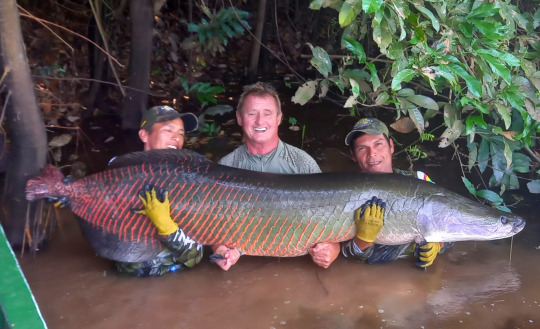
(image: several anglers with an arapaima)
Arapaimas are obligate air-breathers and will drown if they can't get to the surface to breathe. This is accomplished with a specialized swim bladder. The swim bladder is filled with highly vascularized tissue, letting it act like a lung. This pseudo-lung opens into the mouth using a modified gill arch known as the labyrinth organ. Arapaima gills are too small to sustain them, but they can supplement their oxygen intake with the gills. Juveniles are born exclusively using their gills and transition into air-breathers shortly after hatching. Arapaimas can survive up to a full day out of the water. They typically surface to gulp in air every 15-20 minutes. Breathing makes a loud gulping sound that anglers use to target them.
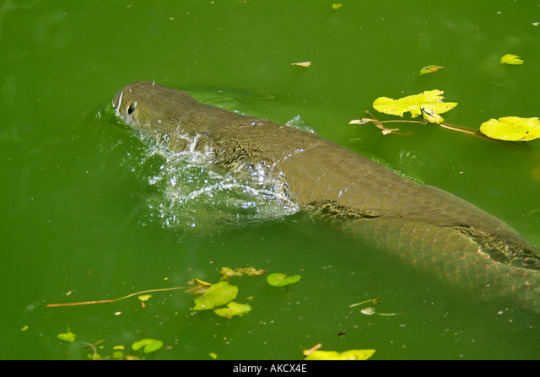
(image: an arapaima at the surface)
Because of their ability to breathe air, arapaimas are top predators in low-oxygen environments. Non-air breathing fish are forced to slow down in water with low levels of dissolved oxygen as they can't get enough oxygen through their gills. Since Arapaimas breathe air, they can easily chase down lethargic smaller fish. They are especially potent predators during the low season, when water levels lower. A combination of rotting vegetation reducing oxygen levels and ponds getting cut off from rivers and losing a supply of oxygen lets the arapaima reign supreme. Arapaimas are primarily predators that feed on smaller fish, though they will hunt other types of animals and eat fruits and seeds. Even land animals aren't safe as arapaimas have been known to launch themselves out of the water to catch animals near the shore. A combination of sharp teeth and their bony tongues are used to debilitate prey.
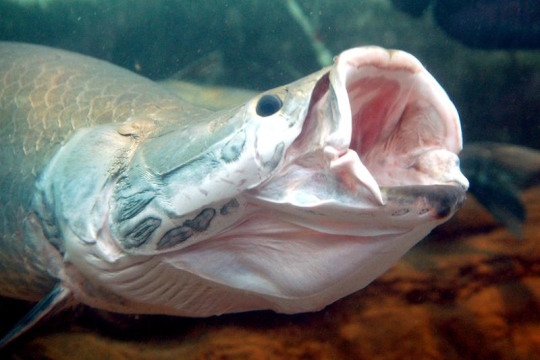
(image: an arapaima with its mouth open)
Not content with powerleveling their attack stat, arapaimas also have excellent defense. Their scales have been compared to bullet proof vests. Each has a hard, mineralized outer layer over multiple layers of collagen fibers. These layers are all oriented at an angle to each other to provide extra strength. This orientation of layers is called a Bouligand-type arrangement and is similar to how plywood is assembled. The harder outer layers and flexible inner layers work together to allow for both strength and flexibility. These scales help provide protection form large predators such as caiman and small threats like biting piranha. They also like provide protection from other arapaima, as the fish are aggressive and will fight each other.

(image: a diagram showing the composition of arapaima scales. source)
You probably wouldn't expect a swimming tank of an animal to be a good parent, but you'd be wrong. Arapaimas work together in mated pairs to build nests for their eggs, then cooperate to guard the nest. Once the eggs hatch, the male will practice mouth brooding, keeping his young safe in his mouth. The female will also help by patrolling the area around the male to ward off predators. They secrete pheromones from their heads to ensure the young don't swim too far away. Eggs are laid either in in the low season or as water levels are starting to rise, ensuring that the young become independent during the high season.

(Image: baby arapaimas)
Arapaima are classified as "data deficient" by the IUCN. This means there isn't enough data to properly assess their conservation needs. They are known to be threatened by overfishing. Arapaima make up a large part of the diet of many South American populations. Habitat loss and pollution are also believed to threaten them. They have been introduced to many areas out of their native range and are an invasive species in placed like Florida, Malaysia, and India.
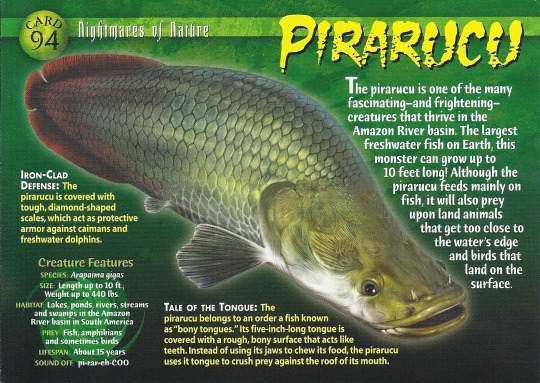
Does anyone else remember these cards? (image: the arapaima card from Weird n' Wild Creatures)
#wet beast wednesday#fishblr#fish#biology#zoology#ecology#animals#aquatic biology#animal facts#absolute unit#arapaima#pirarucu#paiche
1K notes
·
View notes
Text
Day 17 - Jealous kiss
Characters: Solomon x gn!MC
25 kisses challenge Masterlist
Main Masterlist
CW: none, just fluff. Developing relationship.
.
Getting used to only seeing the moon, especially an unfamiliar one, was something that took more of MC’s time than they would like to admit. The darkness, loosing track of time and the drop in temperature were one thing, but it was the lack of vitamin D what proved to be a significant problem. Their body weakened and their mood plummeted to the point where even Lucifer panicked.
Fortunately for all of them, the solution was as simple as adding certain foods to their diet, mainly fish, and of course the brothers bought enough to feed an entire army. In the end, however, MC grew sick of it and resorted to consuming vitamin D supplement pills.
Then they had the dilemma of finishing the whole stack of seafood that filled the entire kitchen, including the fridge, the freezer and the cabinets. Not even Beel could force himself to gulp it down and soon Satan had the genius idea of feeding it to the stray cats.
They would get rid of the awful smell that roamed the house and other cats would visit in hopes of getting more gourmet treats, because where else would they find salmon or trout? At first, obviously, Lucifer refused in fear of any animal creeping inside the house while no one was looking, but once Asmo begged for the damn dead fish to get out, no one dared to complain.
So that’s where they were, the Avatar of Wrath almost crying in happiness while cats climbed all over his body, his younger brother beside him taking selfies with the cutest kittens and MC in a more secluded space giving all of their attention to a particular cat. It had greyish blue eyes and striking long white fur, stained with dirt, but beautiful nonetheless.
A certain sorcerer with similar features stared at them while they cooed at the cat, kissing its nose, scratching its ears and massaging its little paws.
“If I didn’t know you any better”, MC said with uncharacteristic pompousness “I’d think you were jealous”
“Me? Jealous?”
Solomon’s expression was mischievous, but a glint in his eyes betrayed him. He was definitely jealous.
“You must be imagining things, my dear MC”
The term of endearment made their heart flutter, still vulnerable to his teasing even after weeks of endless flirting. Those who weren’t close to them already thought they were dating and after the kiss they’d shared a few days ago during RAD’s latest festival, they might as well be.
It had been a nervous gesture, too short for both of their likings, but MC hadn’t stopped thinking about it. The taste of soda on both of their lips, his hands on their waist, gently keeping them close.
The memory made them feel like a love-struck schoolgirl.
“From the way I see it, you’re simply being too selfish with your affections”
They turned to the side to look at him with an incredulous smile, hugging the cat close to their chest and rubbing its belly. Solomon’s eyebrow twitched at the sight.
“Whatever do you mean?”
“Isn’t it clear?”
“Enlighten me”
Solomon opened his mouth to speak, but his words got stuck in his throat when MC shimmied their way to his body, resting impossibly close to him and letting the cat smell his RAD uniform. He smiled with genuine care and scratched its chin, once again unknowingly increasing MC’s heartbeat.
“Look at him, how handsome he is” murmured MC, their head oriented towards the cat, but their eyes directly looking at the blushing sorcerer “His white hair, his grey eyes… I could kiss him over and over and over again…”
And so they did, hoisting it until their heads were at the same height and enthusiastically pressing loud kisses on the fur. It smelled bad, but they did it anyways.
“Are you being mean on purpose?”
MC laughed at his childish complaint, trying not to make too much fun of his pout and his crossed arms. He only looked at them again when they finally let the cat go and threw themselves at him, making Solomon gasp in surprise.
“You’re funny”
The whisper clashed against his lips and became inaudible to everyone but them.
This kiss was even shorter than the one they shared at the festival, but it eased Solomon’s frown and it made his small smile reappear. He hugged their waist before they could get too far and deepened the kiss, not letting them go until a delighted screech reached their ears.
By the time they turned around, Asmodeus had already taken a picture.
.
.
Taglist: @ourfinalisation @owlisbuffering @chizukimp4 @ravenredwine @darkflowerav @craftysclown @mehkers
#obey me#obey me! shall we date?#om! shall we date#om! swd#obey me x reader#obey me x gender neutral reader#obey me solomon#obey me solomon x reader#solomon x reader#obey me fluff#obey me writing#obey me drabble#25 kisses challenge
236 notes
·
View notes
Text
💖 NUTRITION & WELLBEING EDITION - 10 WEEKS UNTIL 2025 - GLOW UP SERIES [WEEK 10] - 💖
So we’re 10 weeks till 2025, the new year is fast approaching, your energy levels are in the gutter and despite mentally wanting to change your life there’s just something keeping you stuck. You wake up and it’s the same story different day, tired, hungry, moody as hell.
While you might mentally want to change your life, your body needs to be on board and to do that it’s gona need the right foods, drinks and nutrients to have you functioning at your optimal level. Taking drastic action when it comes to changing your diet is how you’re going to see drastic results in your energy levels, productivity and overall wellbeing…
The foundations:
🛌 SLEEP: All those late night movies before bed, Netflix and chill, love-is-blind binging needs to stop immediately. You need a set bed time and you need to be consistent. Waking up and going to sleep at the exact same time every single day. I recommend 10pm - 6am or somewhere around there.
🥱 Sleep with your mouth closed. Use mouth strips from amazon if you dribble, snore, or struggle to sleep properly - breathing through your mouth is most likely the culprit. It’s not natural and disturbs natures rhythm which is breathing through your nose. Mouth strips have been a game changer for me, and highly recommended.
🚫 No screen before bed. This is obvious but those doom scrolling morning and nights are over. Switch it off, read a book, pray, meditate, do what you need to. This is about resting your body before bed so you can sleep well and function at your best the next day.
Sleep supplements: Magnesium oil spray or tablets before bed
🍴 FOODS & DRINKS: 2 litres water MINIMUM per day. Absolutely no alcohol for the next 10 weeks. Strict diet of vegetables, fruits, protein and healthy fats, high quality meats and fish. More herbs into your food. Seeds, whole grains such as Chia, Flaxseed, Pumpkin seed, Bulgar wheat. More pre-and-probiotics. Sprouted veggies. Snack on nuts. No sweets, no cakes, no carbs. No bread, no pasta, no rice, no gluten. No nothing that is not a whole food, or from the earth. You are your own doctor when it comes to food, so you will know what is best for you. Above is the closest diet to nature and has changed my life. Eating vegetables in season. Removing western foods, removing vegetable oil, only drinking structured water, herb teas, and freshly pressed veg juices. Changing your diet might mean you stop eating out, you cut the takeouts, you spend your evenings researching meal preps for Keto, or healthy diet. Your life will completely change when you start feeding your body ALIVE foods, instead of nutrient deficient, processed food that keeps you craving more. Yes you are going against the grain. You will be the minority, but what are the alternatives? Stay binging? Stay eating crap? Stay feeling crap?
Supplements:
Chronium, Berberine for support with blood sugar
D3 + K2, B12, Vitamin C 1000mg, Turmeric, Probiotics,
DIM, Milk Thistle, Selenium, Iodine Drops, Omega 3, Mega GLA for women’s health.
Other:
Get full blood panel done to see any deficiencies
Invest in a continuous glucose monitor from Amazon - see how your body is responding to foods you are eating in real time.
🏃🏽♀️EXERCISE: There is no way around this. You need to do some fucking exercise. Even if you start with 10k steps per day. Just do it. Once you’ve switched up your diet you absolutely WILL have more energy. Join a gym, set the intention, put reminders on your phone affirming you ARE someone whoo does exercise and works out. Leave your gym clothes out before bed. Set yourself up to win. Find a friend or someone to work out with. Look on YouTube for a workout if the gym is not possible. Just try your best. This is a mind over matter. ~You got this.
🧘🏽♀️ Finally…STRESS FREE LIVING…
You can eat all the healthy foods, do your 10k steps but if you are involved in a stressful life, those stress hormones are going to come and f**k shit up. You have to remove stress where possible. This is the NUMBER one health destroyer. Stress literally makes is ill. It depletes your energy, exhausts you, and keeps you in survival - not much different to the animals living in the wild. Your life can be so stress free once you realise you are actually in control of a lot more than you realise. Blocking HIM. Saying no to hanging out with HER. Hanging up the phone. Removing yourself from the drama. Quitting your job. Changing your course. Deleting social media. Switching off the news permanently. Distancing yourself. There is SO much you can do to remove stress. But it’s completely on you. You have to take control if you are serious about changing your life.
That’s all for this week! Next week more advice on your pre-2025 glow-up.
#manifestyourreality#levelupjourney#lawofattraction#manifesting#growthmindset#levelup#manifest#manifestingmindset#levelup confidence lawofattraction powerofthemind#adviceformefromme#glow up#glowup#project 2025
83 notes
·
View notes
Note
Can we see more about pyliod....he's so silly. ♥️ kissing him on the head.
I'm obsessed with how khait mimic real world bulls but also goats in their behaviors. are there any other behaviors/traits they mimic from IRL animals?
Which leads me to the question: what separates livestock from pets?
Esp for brakul, I'm assuming the animals he lived around when he was younger were livestock and meant for eating - but what if you had a favorite? Was it different for janeys? Hibrides?
Also leads me to another question: fish keeping - is it a hobby? Are fish just seen as food or can they be considered decorative?
(please forgive any spelling errors it's 1 in the morning for meeee)
Don't know if you saw this post but this gives a good rundown of khait behavior. They're based on wildebeests and most of the descriptions of their social behavior are accurate to them, other aspects of their behavior is pulled mostly from other bovids (other antelopes mostly. l swear I saw urine self-anointing+wallowing by topi or hartebeest or smth in a documentary once, but in terms of bovids that might just be a goat thing. Cervids also do that). Not much of their behavior is actually based on cattle, besides using cattle as a model to inform the concept of a hypothetical domesticated antelope. There's also some horse influence, though in that case it's pretty much exclusively to inform the concept of a non-horse domestic ungulate used Primarily for riding, and their interactions with humans.
The like, general definition of distinction between livestock/pets would be a venn diagram between 'livestock' 'working animals' and 'pets', with livestock being animals raised for production (meat, wool, fur, leather, eggs, milk, etc), working animals being used for physical labor or otherwise performing utilitarian 'jobs' (plow animals, riding animals, ratters, herders, guardians, etc), and pure pets having no directly 'productive' role and exist for companionship, ornamentation, etc (though the definition of a pet can be pretty nebulous, especially if you're framing it around emotional attachment instead of the lack of a productive angle). These categories can heavily overlap.
This is just a generalized answer (not even in-universe). How a culture defines these concepts separately (if it does at all) is going to vary extensively.
Brakul grew up surrounded by livestock/working animals and virtually no animals kept EXCLUSIVELY for companionship. The core subsistence method is a mix of settled agriculture (producing primarily grain) and seasonal pastoralism of cattle and horses (producing primarily dairy and wool), occasionally supplemented by hunting and fishing of wild game. The diet revolved around dairy and grain with meat being eaten irregularly, especially for people who aren't rich (which in this particular context is primarily measured in the quality and quantity of livestock- someone wealthy in cattle can afford to slaughter more frequently). Slaughtering a cow is a special occasion. Brakul's clan was on the lower end of the livestock wealth scale, so he ate meat infrequently and almost never his Own livestock (mostly eating hunted/fished game, meat given as gifts or in trade, meat provided by the ruling clan by social obligation).
(This is also broadly true of animal husbandry in Real Life across history prior to industrialized farming- most livestock is more valuable alive as a continuously replenishing resource (milk, wool, eggs, pulling plows, etc) and thus would be slaughtered for personal use infrequently. In class stratified societies, the majority of animals raised for meat would often feed upper classes rather than the people actively involved in rearing them. Some pastoralist societies will rarely or virtually never slaughter their animals for meat, as they are wholly relied on for products they produce while alive.)
So Brakul existed in a context where it was very possible to get attached to livestock and working animals. A lot of basic survival revolved around the dairy and wool the livestock provide, there are high emotional stakes in their survival and well-being, so personal attachment to these animals (even those likely destined for slaughter) can come naturally and be beneficial. The concept that's more alien to him is pure companion animals that don't really do anything directly productive. House dogs kind of freak him out because they're SO different from the dogs he was used to (extremely independent livestock guardians that don't really bond with people, and herding dogs that bond readily with their owners but are notably intelligent and self-sufficient). Encountering dogs that are utterly dependent on their owners and desperate for human attention was like 'what the fuck is wrong with that thing? sad'.
Pretty much the exact reverse situation for the characters from noble families. They would rarely be in close contact with livestock or subsistence level working animals (if anything, they/their families own land and livestock that is entirely raised by peasant workers), and instead would have most contact with pets/ornamental animals/leisure type working animals (hunting dogs, sport khait), and animals used in transportation (cart khait and oxen). They have VERY clear, clean-cut delineations between 'pet' and 'food' (though still not as much as is common in industrialized societies where most people are completely and utterly disconnected from the sources of their food. They're still Connected to the process, seeing animals being slaughtered is a part of daily life). They also would have eaten meat on a much more regular basis, while having little to no personal involvement in its production.
Wardi culture as a whole is not big on companion dogs (there are a few companion dog 'breeds' within the region, but most are hunting or herding dogs). Polecats are by far the most common companion animal in this cultural sphere (they technically fill working functions as ratters, but are mostly kept as housepets). Other animals kept purely as pets are mainly ornamental fowl and ducks. There's also a kind of pygmy horse breed that is kept as a companion animal (reminder that horses in this setting share the size range of goats).
Faiza, Couya, Janeys and Hibrides all grew up with pet polecats and hunting dogs, and sport khait owned by their families. Hibrides had pygmy horses as a kid. In the present day, Janeys' household has two hunting dogs that he doesn't like all that much, he also got two polecats for his children (one of which died tragically after being thrown from a window by his eldest), and has 14 total khait (12 of which are Brakul's) (technically owns another herd and a herd of cattle, but has nothing to do with them. It's an investment). Faiza likes dogs quite a bit and owns three bred hunting dogs and one feral dog she took off the street, also two khait (she owns land and the animals are kept there).
Re: fishkeeping. There's going to be plenty of variation in a global context, but broadly speaking keeping fish as a hobby/for display/other non-meat purposes is going to be on the rarer side in this setting. This is a limited practice in Imperial Wardin (you'll get the occasional wealthy home keeping fish in a courtyard pool but there's no traditions built around it). In terms of nearby civilizations, it's a much more significant practice in Bur, where water gardens with ornamental plants and fish are integrated into temples, city layouts, and wealthy homes.
#Also keeping animals PURELY for companionship is going to be rare in this setting overall. The vast majority of the world's population#is existing at subsistence level and maintenance of an animal that provides no practical benefit in return (as much as one can argue#that emotional companionship is a practical benefit) is unsustainable in a lot of contexts.#Though sometimes the 'practical benefit' can be intrinsic to the animal enough to lower this barrier- ie any dog can benefit its owners#by barking to alert of intruders (and may be able to mostly fend for itself and not require a massive investment in resources)
29 notes
·
View notes
Text
Boosting Aquatic Productivity: The Role of VinMos in Improving Feed Conversion Ratios
In aquaculture, the feed conversion ratio (FCR) is a critical metric that directly impacts the efficiency and profitability of farming operations. VinMos, a specialized prebiotic, has emerged as a game-changer in improving FCR for fish and shrimp. By enhancing nutrient absorption and promoting gut health, VinMos plays a vital role in boosting aquatic productivity and ensuring sustainable farming practices.
VinMos enhances the gut microbiome by fostering the growth of beneficial bacteria, which are essential for efficient nutrient digestion and absorption. This improved gut health allows fish and shrimp to make better use of their feed, converting more of it into body mass. As a result, farmers can achieve higher growth rates with less feed, optimizing FCR and reducing overall feed costs.
Improving FCR not only benefits the economic aspects of aquaculture but also has significant environmental implications. By reducing the amount of feed required to achieve desired growth, VinMos helps to minimize waste and lower the environmental footprint of aquaculture operations. This aligns with the growing demand for sustainable and eco-friendly farming practices, making VinMos a valuable asset for modern aquaculture.
In addition to its impact on FCR, VinMos also supports the overall health and well-being of aquatic species. A healthy gut microbiome enhances the immune response, protecting fish and shrimp from diseases and infections. This leads to higher survival rates and a reduced need for antibiotics and other treatments, further contributing to the sustainability and efficiency of aquaculture operations.
In summary, VinMos is instrumental in boosting aquatic productivity by improving feed conversion ratios and promoting gut health. Its benefits extend beyond economic gains, supporting sustainable farming practices and enhancing the overall health of fish and shrimp. By incorporating VinMos into their feeding protocols, aquaculture farmers can achieve more efficient, profitable, and environmentally friendly operations, ensuring the long-term success of their businesses.
For more information visit us:
0 notes
Note
What do you feed the Bamfs?
Do they prefer fast food, junk food, soda, or snacks? Or does it depend on the specific bamf???
And how often are they spoiled with food or drinks?
The bamfs naturally are healthy eaters, they eat a based carnivorous diet. They have sharp teeth meant for tearing and ripping, they have sharp molars that are also meant to dig into chunks and rip back to support their canines. They generally swallow big chunks of food and don't chew often due to their molars being sharpened.
Usually they don't eat anything besides meat and supplements, but they get veggies (only specific ones) and fruits too.
They eat things like chicken, beef, waterfowl, etc. They don't like fish. They like most fruits, and some vegetables. But they are picky. Also, every bamf is different on the things they like! Some prefer a specific protein, some prefer a specific fruit or veggie.
They all generally have a sweet tooth, so I tend to give them treats often if they've eaten their meals. They like candy and sweet desserts too. Ice cream, brownies, cobbler, etc. They also like things like pancakes, chips, snacks. They can eat 'unhealthy' foods occasionally, but too much makes them sick.
I'd say their diet is 70% meat, 10% fruits and veggies, and 20% things like junk or snacks. They eat healthy most of the time but they all gather and beg with their puppy eyes and damnit you can't say no. It's my kryptonite.
52 notes
·
View notes